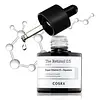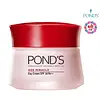What's inside
What's inside
 Key Ingredients
Key Ingredients

 Benefits
Benefits

 Concerns
Concerns

 Ingredients Side-by-side
Ingredients Side-by-side

Water
Skin ConditioningCyclopentasiloxane
EmollientGlycerin
HumectantEthylhexyl Methoxycinnamate
UV AbsorberDimethicone Crosspolymer
Emulsion StabilisingNiacinamide
SmoothingCaprylic/Capric Triglyceride
MaskingTitanium Dioxide
Cosmetic ColorantPEG-10 Dimethicone
Skin ConditioningPotassium Chloride
Caprylyl Methicone
Skin ConditioningHydrolyzed Sodium Hyaluronate
Skin ConditioningSodium Hyaluronate
HumectantSodium Acetylated Hyaluronate
HumectantSodium Hyaluronate Crosspolymer
HumectantHydrolyzed Collagen
EmollientPhenoxyethanol
PreservativeMica
Cosmetic ColorantParfum
MaskingAlumina
AbrasiveDisteardimonium Hectorite
StabilisingStearic Acid
CleansingMagnesium Sulfate
Methicone
EmollientSucrose Distearate
EmollientTocopheryl Acetate
AntioxidantCholesterol
EmollientDisodium EDTA
PEG-4 Laurate
EmulsifyingHexylresorcinol
AntimicrobialPEG-4 Dilaurate
EmulsifyingAluminum Hydroxide
EmollientDimethicone
EmollientCetyl Alcohol
EmollientRetinyl Propionate
Skin ConditioningBHT
AntioxidantPEG-4
HumectantIodopropynyl Butylcarbamate
PreservativeCeramide Ng
Skin ConditioningSodium Ascorbyl Phosphate
AntioxidantHydroxystearic Acid
CleansingButylene Glycol
HumectantSodium Sulfate
Sodium Chloride
MaskingPentylene Glycol
Skin ConditioningSorbitan Laurate
EmulsifyingTocopherol
AntioxidantHydroxyethylcellulose
Emulsion StabilisingPalmitic Acid
EmollientAcetyl Dipeptide-1 Cetyl Ester
Skin ConditioningSodium Benzoate
MaskingArachidic Acid
CleansingEthylhexylglycerin
Skin ConditioningCI 17200
Cosmetic ColorantWater, Cyclopentasiloxane, Glycerin, Ethylhexyl Methoxycinnamate, Dimethicone Crosspolymer, Niacinamide, Caprylic/Capric Triglyceride, Titanium Dioxide, PEG-10 Dimethicone, Potassium Chloride, Caprylyl Methicone, Hydrolyzed Sodium Hyaluronate, Sodium Hyaluronate, Sodium Acetylated Hyaluronate, Sodium Hyaluronate Crosspolymer, Hydrolyzed Collagen, Phenoxyethanol, Mica, Parfum, Alumina, Disteardimonium Hectorite, Stearic Acid, Magnesium Sulfate, Methicone, Sucrose Distearate, Tocopheryl Acetate, Cholesterol, Disodium EDTA, PEG-4 Laurate, Hexylresorcinol, PEG-4 Dilaurate, Aluminum Hydroxide, Dimethicone, Cetyl Alcohol, Retinyl Propionate, BHT, PEG-4, Iodopropynyl Butylcarbamate, Ceramide Ng, Sodium Ascorbyl Phosphate, Hydroxystearic Acid, Butylene Glycol, Sodium Sulfate, Sodium Chloride, Pentylene Glycol, Sorbitan Laurate, Tocopherol, Hydroxyethylcellulose, Palmitic Acid, Acetyl Dipeptide-1 Cetyl Ester, Sodium Benzoate, Arachidic Acid, Ethylhexylglycerin, CI 17200
 Reviews
Reviews

Ingredients Explained
These ingredients are found in both products.
Ingredients higher up in an ingredient list are typically present in a larger amount.
BHT is a synthetic antioxidant and preservative.
As an antioxidant, it helps your body fight off free-radicals. Free-radicals are molecules that may damage your skin cells.
As a preservative, it is used to stabilize products and prevent them from degrading. Specifically, BHT prevents degradation from oxidation.
The concerns related to BHT come from oral studies; this ingredient is currently allowed for use by both the FDA and EU.
However, it was recently restricted for use in the UK as of April 2024.
Learn more about BHTThis ingredient is an emollient, solvent, and texture enhancer. It is considered a skin-softener by helping the skin prevent moisture loss.
It helps thicken a product's formula and makes it easier to spread by dissolving clumping compounds.
Caprylic Triglyceride is made by combining glycerin with coconut oil, forming a clear liquid.
While there is an assumption Caprylic Triglyceride can clog pores due to it being derived from coconut oil, there is no research supporting this.
Learn more about Caprylic/Capric TriglycerideTocopherol (also known as Vitamin E) is a common antioxidant used to help protect the skin from free-radicals and strengthen the skin barrier. It's also fat soluble - this means our skin is great at absorbing it.
Vitamin E also helps keep your natural skin lipids healthy. Your lipid skin barrier naturally consists of lipids, ceramides, and fatty acids. Vitamin E offers extra protection for your skin’s lipid barrier, keeping your skin healthy and nourished.
Another benefit is a bit of UV protection. Vitamin E helps reduce the damage caused by UVB rays. (It should not replace your sunscreen). Combining it with Vitamin C can decrease sunburned cells and hyperpigmentation after UV exposure.
You might have noticed Vitamin E + C often paired together. This is because it is great at stabilizing Vitamin C. Using the two together helps increase the effectiveness of both ingredients.
There are often claims that Vitamin E can reduce/prevent scarring, but these claims haven't been confirmed by scientific research.
Learn more about Tocopherol